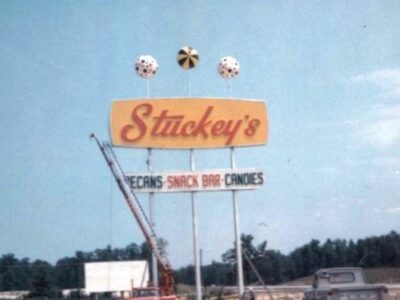One thing we remember most about traveling when we think back to those early family vacations of the 1960s and 1970s are the futuristic and exotic looking buildings we would sometimes dine in, refuel at or even just pass by on our way to wherever mom and dad were taking us. This roadside architecture, known as Googie and Tiki, respectively, is a type of design that grew out of evolution of the American business after World War II. It was a time when traveling by car became part of our national culture, and the playful architecture of Googie and Tiki reflected both America’s optimism and imagination of the age.
What is Googie ?
Architecture critic Douglas Haskell came up with the name Googie as he was driving around Los Angeles working on a story about these flashy new coffee shops that were popping up all over the city. When he came to one of these coffee shops called Googie’s, with its vibrant colors, its myriad of materials, its daring shapes, and over-the-top signage, he decided to name this optimistic, experimental and exciting architectural style after it.
Think Space Age Jetsons, Seattle’s Space Needle and the architecture of the 1965-1965 New York World’s Fair, and you’ll get an idea of what Googie is. In fact, many of the fixtures of roadside America, from diners and coffee shops to gas stations and motels, took full advantage of the Googie style, many of which can be found still standing today throughout LA.
Glass and steel are usually the main components that make up Googie buildings, but they can also be splashy and flashy with blinking and pointing lights. Other Googie details may include boomerang and palette shapes as well as other Atomic and Space Age designs like atom motifs, starbursts, Flying saucer and trapezoid shapes, sharp angles, and saw-toothed roof lines
What is Tiki ?
Like Googie, Tiki is a subculture of the Modernist Era. This style of architecture and design really took off after World War II when many soldiers returned from the South Pacific. It was fueled further by popular movies of the time including the film South Pacific. More American pop culture than Polynesian or Asian culture, Tiki is a mishmash of well-known symbols borrowed from East Asia and islands of the South Pacific and Oceania. In fact, a lot of Tiki design was created by people who have never even visited these areas but had vivid imaginations of what that part of the world must have been like.
It was in the first couple of decades after World War II that it seemed there was a Tiki inspired bar or restaurant in every major city in America where anyone could get flaming cocktails and pu pu platters. In fact, the style even began to slowly seep into the designs of homes, churches, and even Stuckey’s, who actually started adopting a bit of the Tiki style starting in the late 1960s with their teal blue pagoda-style roof which would soon become their trademark design for its newer franchises.
By the mid-1960s and into the 1970s, the trend was hated by the architecturally elite crowd and the youth of America saw it as ignorant and over-the-top. By the 1980s most Tiki-themed establishments were torn down and all but disappeared.
Recently, however there has been a revival in Tiki of sorts and many are starting to appreciate the Tiki culture and its many interesting and beautiful features such as tikis (meaning a large wooden image of a human figure) , carved beams, lava rock, bamboo, ornamental shells and coconuts, both real and imitation palm trees, thatched roofs, A-frame and extremely steep peaked roofs, and indoor waterfalls.
Roadside Architecture
More and more people starting spending time in their cars traveling all throughout the country after President Eisenhower signed the Federal Highway Act in 1956 and the building of the Interstate Highway System began. Many of these 20th century roadside icons were created to attract American vacationing families and early road trippers into their establishments and purchase whatever they were selling. Howard Johnsons’ orange roofs and the Polynesian style of Trader Vic’s are examples of those times when Americans dreamed of not only exploring space, but also other exotic locations right here on Earth.
If you want to see some examples of Googie and Tiki architecture, why not stop by the teal blue pagoda-style roofs that have been inspiring people for years to “relax, refresh and refuel” at Stuckey’s. We’re still making the finest pecan candies and still serving up the same highway happiness we’ve served since 1937, so stop in and pick up a few pecan log rolls or other Stuckey’s souvenirs for the folks back home.
Can’t find any of our Stuckey’s locations near you? No problem, you can still find highway happiness on the information superhighway and order some Stuckey’s pecan log rolls and other Stuckey’s merchandise right to your front door. Visit us at stuckeys.com for more information.

Whether your next road trip is by car or by rail, it’s not really a road trip without taking Stuckey’s along. From our world famous Stuckey’s Pecan Log Rolls to our mouthwatering Hunkey Dorey, Stuckey’s has all the road trips snacks you’ll need to get you where you’re going.
For all of the pecany good treats and cool merch you’ll need for your next big road adventure, browse our online store now!
Stuckey’s – We’re Making Road Trips Fun Again!
